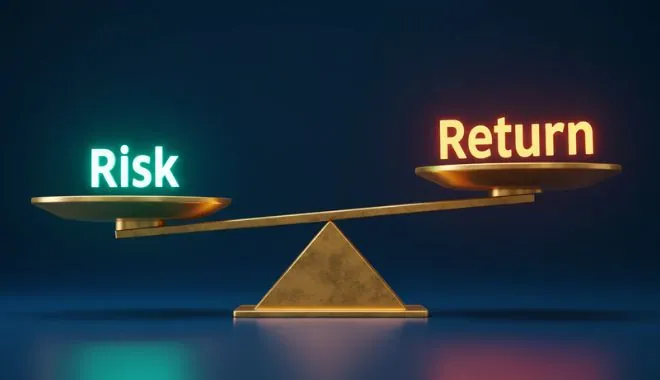Physical Address
304 North Cardinal St.
Dorchester Center, MA 02124

Index funds have become a buzzword in the investing world — and for good reason. They’re simple, affordable, and surprisingly effective for both beginners and seasoned investors. Yet, despite their reputation for stability, not all index funds are created equal. Some carry more risk, while others offer steadier, more predictable returns. So, how do they really differ when it comes to risk and returns?How Do Index Funds Differ in Risk and Returns? Let’s break it down in plain English.
An index fund is a type of mutual fund or exchange-traded fund (ETF) that aims to replicate the performance of a specific market index, such as the S&P 500 or Nasdaq 100. Instead of handpicking individual stocks, an index fund automatically invests in all the companies within that index — giving you instant diversification.
In short: when you invest in an index fund, you’re investing in the entire market, not just a single company. That’s why it’s often called the “lazy” or “set-and-forget” way to invest.
The secret behind their popularity? Low costs and consistent performance. Unlike actively managed funds, index funds don’t require a manager constantly buying and selling stocks — which means lower fees. Plus, studies have repeatedly shown that most active managers fail to beat the market over time. Index funds, on the other hand, are the market.

In investing, “risk” refers to how much your investment’s value can fluctuate over time. Stocks, for example, tend to rise and fall with market conditions. The more volatile the asset, the higher its risk.
Index funds, by nature, inherit the risk level of the markets or sectors they track. A U.S. large-cap index fund is generally less risky than one tracking emerging markets.
“Return” is simply what you earn from your investment — the gain (or loss) compared to what you originally invested. Returns come from price appreciation and dividends or interest payments. Generally, higher risk comes with the potential for higher returns.
This is the golden rule of investing: no reward without risk. Safer investments like government bonds yield modest returns, while stock-based index funds can bring higher growth — along with bigger ups and downs.
One of the main benefits of index funds is diversification. By investing in hundreds (or even thousands) of stocks or bonds, your risk is spread out. If one company stumbles, it barely dents your portfolio because others can make up for it.
However, index funds can’t avoid systemic risk — the kind that affects the entire market. During recessions or global crises, even well-diversified index funds will drop in value. But historically, markets recover over time, rewarding patient investors.
Tracking error measures how closely an index fund mirrors its benchmark index. A smaller tracking error means better performance alignment. High expense ratios, trading delays, or poor management can cause tracking errors — slightly reducing returns.
Most index funds are passively managed, meaning there’s minimal human interference. The goal is to follow the index exactly, which reduces both costs and emotional decision-making. In contrast, actively managed funds try to beat the market — often failing and charging higher fees for the attempt.
Expense ratios (the annual fee you pay to manage the fund) might look small — say, 0.10% — but over decades, they can significantly erode your returns. Always look for low-cost funds from reputable providers.
These funds track the 500 largest publicly traded U.S. companies. They’re considered relatively stable since they represent a broad slice of the economy — but they still fluctuate with the overall stock market.
These cover everything from small startups to big corporations, giving you exposure to the entire U.S. market. They’re more diversified but can be slightly more volatile because of their small-cap exposure.
Government bond index funds invest in U.S. Treasuries or other government-backed securities. They’re typically low-risk, ideal for conservative investors or those nearing retirement.
These invest in company-issued bonds. They offer higher returns than government bonds but also carry higher default risk, depending on the issuing company’s credit quality.
International index funds track foreign markets. Developed market funds (like Europe or Japan) are more stable, while emerging markets (like India or Brazil) offer higher growth potential — and more volatility.
Stock-based index funds are the most volatile, while bond funds are steadier. International and sector-specific funds tend to experience even larger swings due to global events or concentrated exposure.
Funds that focus on one industry, like technology or energy, are more sensitive to changes in that sector. While they can deliver high rewards during booms, they’re riskier during downturns.
Currency fluctuations, political instability, and regulatory differences all affect international index funds. Investors should understand these external factors before diving in.

Historically, U.S. stock index funds like the S&P 500 have provided average annual returns of 7–10% over the long run, while bond funds offer 2–5%. International funds vary widely, depending on regional growth.
Stock-based funds perform best during economic expansions, while bond funds often hold up better during recessions. A mix of both can smooth out your returns through different market cycles.
Reinvesting dividends can significantly boost long-term returns through compounding — where your earnings start earning their own earnings. It’s the snowball effect that builds wealth over time.
Trying to predict the market’s ups and downs is nearly impossible. Most experts agree that staying invested through good and bad times produces better results than trying to time exits and entries.
Even a 1% difference in fees can drastically affect your final wealth. Over 30 years, a 0.10% fee fund can outperform a 1% fee fund by tens of thousands of dollars.
Some index funds automatically rebalance, ensuring your portfolio stays aligned with the market index. This keeps risk consistent without manual intervention.
Your asset allocation — the mix of stocks, bonds, and cash — is the biggest determinant of risk and return. Younger investors often hold more stocks, while older investors lean toward bonds.
Combining different types of index funds (like stock and bond funds) spreads risk and creates a more balanced portfolio that can weather various market conditions.
Over time, certain assets grow faster than others, throwing your allocation off balance. Periodic rebalancing (selling some winners, buying laggards) helps maintain your target risk level.
If market drops make you lose sleep, lean toward bond-heavy funds. If you can stomach volatility for higher growth, stock-heavy funds might be your match.
For long-term goals like retirement, total market or S&P 500 funds are excellent choices. For short-term stability, consider government bond funds.
While past performance isn’t a guarantee of future results, consistent long-term returns and low fees are good indicators of a reliable index fund.
Wrong. Index funds can lose value just like any other investment — especially during bear markets.
Even funds tracking the same index can differ in fees, tracking accuracy, and management quality. Always compare before investing.
Ironically, many investors outperform active managers by choosing low-cost index funds — simply because they avoid high fees and emotional decisions.

Ethical investing is on the rise. ESG (Environmental, Social, and Governance) index funds focus on companies that meet sustainability or ethical standards — blending values with profit.
Artificial intelligence is making fund management smarter and more efficient. AI tools now optimize tracking accuracy and rebalance portfolios faster than ever.
Expect continued growth in low-cost, customizable funds. As technology evolves, index investing will only become more precise and accessible to everyone.
How Do Index Funds Differ in Risk and Returns? Index funds offer one of the most reliable paths to wealth creation for the average investor. They provide diversification, low costs, and market-matching returns without requiring daily management. However, it’s essential to understand that not all index funds share the same risk or reward potential. Your best strategy is to align your fund choices with your personal goals, time horizon, and risk comfort.
Remember: investing isn’t about chasing the highest return — it’s about achieving the right return for you.
Yes, index funds are perfect for beginners. They’re easy to understand, diversified, and require little maintenance.
Yes, especially during market downturns. But long-term investors usually recover and profit as markets grow over time.
Government bond index funds are considered the safest, though they also offer the lowest returns.
Historically, stock-based index funds average 7–10% annually, while bond-based ones range from 2–5%.
Ideally, for at least 5–10 years. The longer you stay invested, the more likely you are to benefit from market recovery and compounding growth.